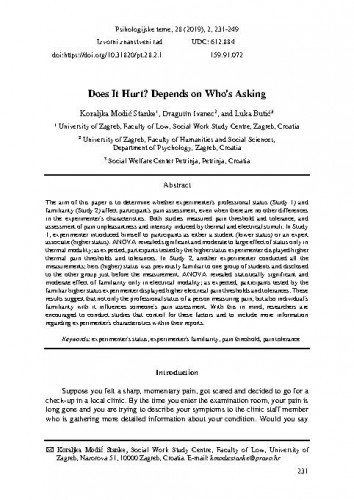The aim of this paper is to determine whether experimenter's professional status (Study 1) and familiarity (Study 2) affect participant's pain assessment, even when there are no other differences in the experimenter's characteristics. Both studies measured pain threshold and tolerance, and assessment of pain unpleasantness and intensity induced by thermal and electrical stimuli. In Study 1, experimenter introduced himself to participants as either a student (lower status) or an expert associate (higher status). ANOVA revealed significant and moderate to large effect of status only in thermal modality; as expected, participants tested by the higher status experimenter displayed higher thermal pain thresholds and tolerances. In Study 2, another experimenter conducted all the measurements; hers (higher) status was previously familiar to one group of students and disclosed to the other group just before the measurement. ANOVA revealed statistically significant and moderate effect of familiarity only in electrical modality; as expected, participants tested by the familiar higher status experimenter displayed higher electrical pain thresholds and tolerances. These results suggest that not only the professional status of a person measuring pain, but also individual's familiarity with it influences someone's pain assessment. With this in mind, researchers are encouraged to conduct studies that control for these factors and to include more information regarding experimenter's characteristics within their reports.; Cilj je ovoga rada bio utvrditi utječu li profesionalni status (prvo istraživanje) i poznatost (drugo istraživanje) eksperimentatora na procjenu boli sudionika, čak i kada nema drugih razlika u karakteristikama eksperimentatora. U oba su istraživanja mjereni prag i tolerancija boli te procjene neugode i intenziteta boli izazvane toplinskim i električnim podražajima. U prvom se istraživanju eksperimentator predstavio sudionicima kao student (niži status) ili kao stručni suradnik (viši status). ANOVA je pokazala značajan i umjeren do velik učinak statusa eksperimentatora samo u termalnom modalitetu; sudionici su čije je mjerenje provodio eksperimentator višeg statusa, u skladu s očekivanjima, pokazivali viši prag i toleranciju boli na toplinske podražaje. U drugom je istraživanju sva mjerenja provela eksperimentatorica čiji je (viši) status jednoj grupi studenata bio otprije poznat, dok je drugoj grupi bio otkriven neposredno prije mjerenja. ANOVA je pokazala statistički značajan i umjeren učinak poznatosti samo u električnom modalitetu; sudionici čije je mjerenje provodila prethodno poznata eksperimentatorica višeg statusa pokazivali su viši prag i toleranciju boli na električne podražaje, što je bilo očekivano. Ovi rezultati sugeriraju da na procjenu boli pojedinaca ne utječe samo profesionalni status osobe koja mjeri bol već i njihova prethodna upoznatost s njime. Imajući to na umu, istraživače se potiče da prilikom budućih istraživanja kontroliraju ove čimbenike te da u radove uključe detaljnije informacije o karakteristikama eksperimentatora
Sažetak

 Psihologijske teme : 28,2(2019) / glavna i odgovorna urednica Barbara Kalebić Maglica.
Psihologijske teme : 28,2(2019) / glavna i odgovorna urednica Barbara Kalebić Maglica.